Paper Menu >>
Journal Menu >>
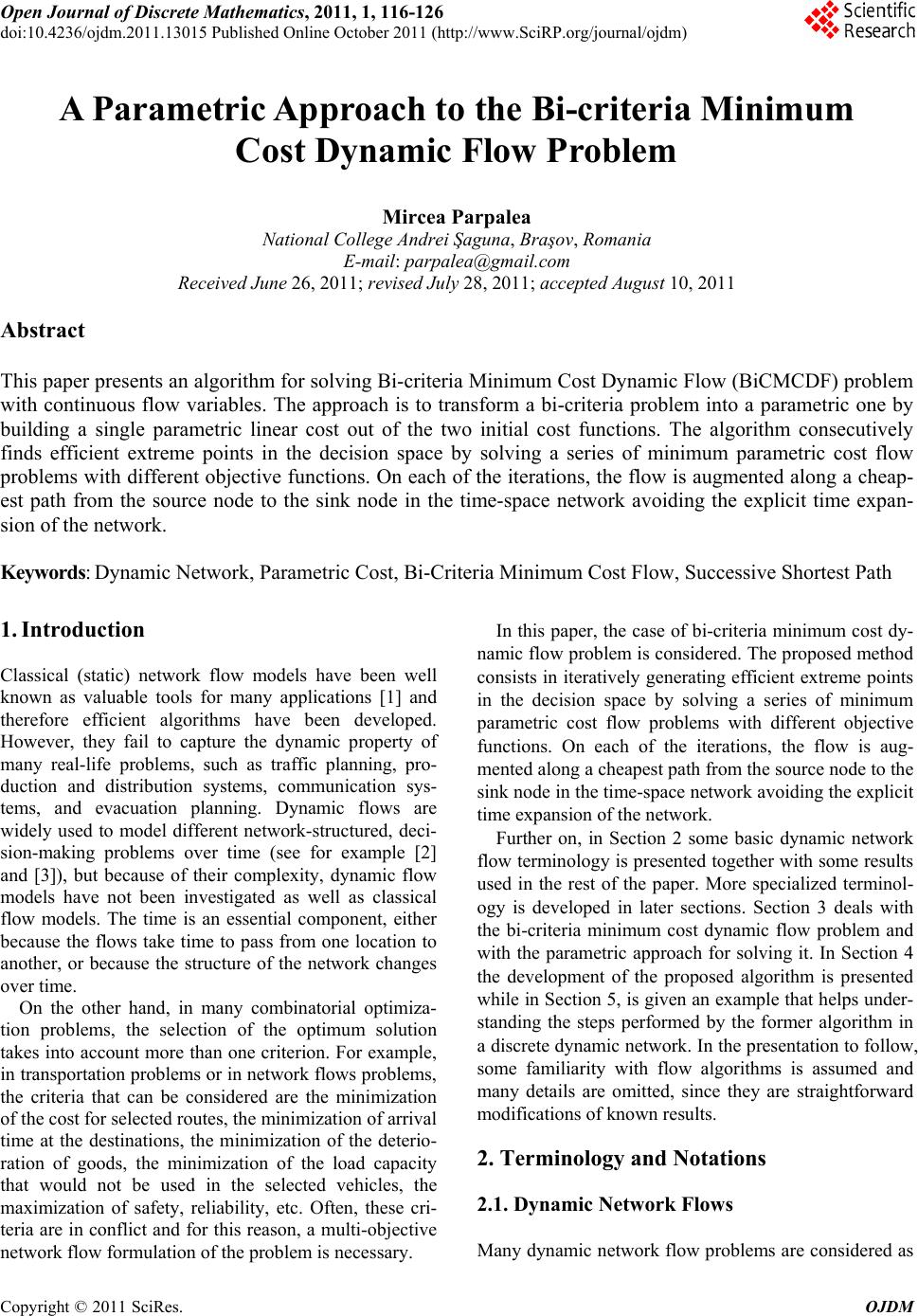 Open Journal of Discrete Mathematics, 2011, 1, 116-126 doi:10.4236/ojdm.2011.13015 Published Online October 2011 (http://www.SciRP.org/journal/ojdm) Copyright © 2011 SciRes. OJDM A Parametric Approach to the Bi-criteria Minimum Cost Dynamic Flow Problem Mircea Parpalea National College Andrei Şaguna, Braşov, Romania E-mail: parpalea@gmail.com Received June 26, 2011; revised July 28, 2011; accepted August 10, 2011 Abstract This paper presents an algorithm for solving Bi-criteria Minimum Cost Dynamic Flow (BiCMCDF) problem with continuous flow variables. The approach is to transform a bi-criteria problem into a parametric one by building a single parametric linear cost out of the two initial cost functions. The algorithm consecutively finds efficient extreme points in the decision space by solving a series of minimum parametric cost flow problems with different objective functions. On each of the iterations, the flow is augmented along a cheap- est path from the source node to the sink node in the time-space network avoiding the explicit time expan- sion of the network. Keywords: Dynamic Network, Parametric Cost, Bi-Criteria Minimum Cost Flow, Successive Shortest Path 1. Introduction Classical (static) network flow models have been well known as valuable tools for many applications [1] and therefore efficient algorithms have been developed. However, they fail to capture the dynamic property of many real-life problems, such as traffic planning, pro- duction and distribution systems, communication sys- tems, and evacuation planning. Dynamic flows are widely used to model different network-structured, deci- sion-making problems over time (see for example [2] and [3]), but because of their complexity, dynamic flow models have not been investigated as well as classical flow models. The time is an essential component, either because the flows take time to pass from one location to another, or because the structure of the network changes over time. On the other hand, in many combinatorial optimiza- tion problems, the selection of the optimum solution takes into account more than one criterion. For example, in transportation problems or in network flows problems, the criteria that can be considered are the minimization of the cost for selected routes, the minimization of arrival time at the destinations, the minimization of the deterio- ration of goods, the minimization of the load capacity that would not be used in the selected vehicles, the maximization of safety, reliability, etc. Often, these cri- teria are in conflict and for this reason, a multi-objective network flow formulation of the problem is necessary. In this paper, the case of bi-criteria minimum cost dy- namic flow problem is considered. The proposed method consists in iteratively generating efficient extreme points in the decision space by solving a series of minimum parametric cost flow problems with different objective functions. On each of the iterations, the flow is aug- mented along a cheapest path from the source node to the sink node in the time-space network avoiding the explicit time expansion of the network. Further on, in Section 2 some basic dynamic network flow terminology is presented together with some results used in the rest of the paper. More specialized terminol- ogy is developed in later sections. Section 3 deals with the bi-criteria minimum cost dynamic flow problem and with the parametric approach for solving it. In Section 4 the development of the proposed algorithm is presented while in Section 5, is given an example that helps under- standing the steps performed by the former algorithm in a discrete dynamic network. In the presentation to follow, some familiarity with flow algorithms is assumed and many details are omitted, since they are straightforward modifications of known results. 2. Terminology and Notations 2.1. Dynamic Network Flows Many dynamic network flow problems are considered as  M. PARPALEA 117 extensions of static network flow problems. These in- clude maximum dynamic flow and minimum cost dy- namic flow problems. The maximum dynamic flow problem seeks a dynamic flow which sends as many as possible a commodity from a single source to a single sink of the network within the time horizon T. The minimum cost dynamic flow problem seeks a dynamic flow that minimizes the total shipment cost of a com- modity in order to satisfy demands at certain nodes within T. 2.2. Discrete-Time Dynamic Network Flows A discrete dynamic network is a directed graph where is a set of nodes with ,,GNAT ,,Ni i Nn, A is a set of arcs with ,,aa A m , and T is a finite time horizon discretized into the set 1, , 0, H T ,ij . An arc a from node i to node j is usu- ally also denoted by . The following functions are associated with each arc ,aijA : the time-de- pendent capacity (upper bound) function ,;uij , which represents the maximum amount of flow that can enter the arc at time :0,1, ,T uA ,ij , the time-dependent transit time function ,;hij , , and the time-dependent cost function :0,1, ,T ,;cij hA , :0,1,,TcA which represents the cost for sending one unit of flow through the arc ,ij at time . Time is measured in discrete steps, so that if one unit of flow leaves node i at time on arc , one unit of flow arrives at node j at time ,j ,;j ai hi , where ,;hij is the transit time on arc a. The time horizon T is the time until which the flow can travel in the network. The demand-supply func- tion vi ;, represents the de- mand of node i at the time-moment , if vi or the supply of node i at the time-moment , if . The network has two special nodes: a source node s with for and there exists at least one moment of time 0 such that ; and a sink node t with for and there exists at least one moment of time 1 such that . The condition required for the flow to :0,1,vN N 0 ;vi 1, ,T ;0vt 0 vi ,T 0 vs 0 ;vs 0,1,,T 0,1, ;0 0,1,,T ;0 0 ,T ; , ,T , ,T 0, 1 ; 0,1 0,1 vt exist it that 0,1,,TiN Definition 1: [4] A feasible dynamic flow ,; f ij (feasible flow over time) on with time horizon T is a function ,,hcT ,,T ,,,GN Au :0,1fA that satisfies the following constraints: ,, ,; 0 ,;,;,;; , jijAj jiA hji fijf jihjivi ;0,1,,iN T (1.a) 0,;,;,0,1,,,, ; f ijuijTij A (1.b) ,;0, ,,,;1, f ijijAT hijT (1.c) where ,; f ij determines the rate of flow (per time unit) entering arc ,ij at time . Capacity constraints (1.b) mean that in a feasible dy- namic flow, at most ,;uij units of flow can enter the arc ,ij at the time-moment . It is easy to ob- serve that the flow does not enter arc at time ,ij if it has to leave the arc after time T; this is ensured by condition (1.c). The total cost of the dynamic flow ,; f ij in a discrete-time dynamic network is defined as: 0,1,,, ,; ,; TijA Cffij cij (2) 2.3. Time-Space Network In the discrete time model, a useful tool for studying the minimum cost flow over time problem is the time-space network. The time-space network is a static network constructed by expanding the original network in the time dimension by considering a separate copy of every node iN at every discrete time step in the time hori- zon T, 0,1, ,T . A node-time pair (NTP) ,i refers to a particular node iN at a particular time step , i.e., 0,1,,T 0,1,T ,iN ,. The NTP ,i1 is said to be linked to the NTP 2 ,j if either i) ij,A and 21 1 ,;hi j , or ii) ,ji A and ,;hji 12 2 . Definition 2: [5] The time-space network of the original dynamic network G is defined as follows: T G :,|,0,1,, T NiiN T ; (3.a) :,,,,; 0,;, ,; T Aa ijhij T hijijA (3.b) :;for TT uauaa A ; (3.c) :;for TT cacaaA . (3.d) For every arc ,ij A with traversal time ,;hij , capacity ,;uij and cost ,;cij , the time-space network contains arcs T G ,,ij ,;hij, for 0,1,,, ;Thij with capacities ,;uij and costs ,;jci . Copyright © 2011 SciRes. OJDM 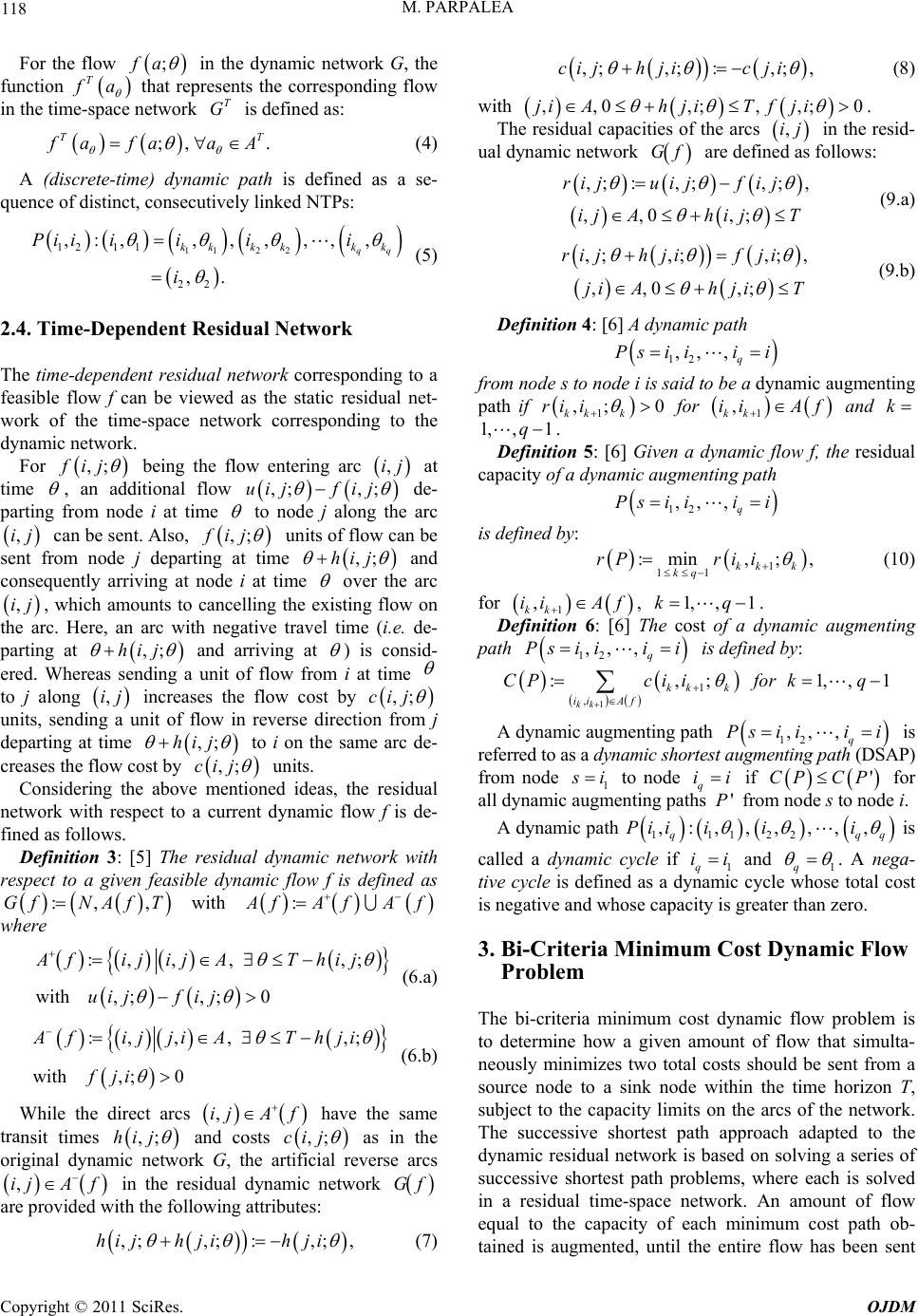 M. PARPALEA 118 flow For the ;fa in the dynamic network G, the function T fa that re e presents the corresponding flow in the timnetwork T G is defined as: ;, . TT fa faA e-spac a (4) A (discrete-time) dynamic path qu is defined as a se- ence of distinct, consecutively linked NTPs: ,:,,, ,,,Pi iiiii 112 2 121 1 22 , ,. qq kkk kkk i (5) .4. Time-Dependent Residual Network he time-dependent residual network corresponding to a 2 T feasible flow f can be viewed as the static residual net- work of the time-space network corresponding to the dynamic network. For ,; f ij being the flow entering arc ,ij at time , an additional flow ,; ,uijf ij; de- partinfrom node i at time g to arc node j along the ,ij can be sent. Also, ,; f ij units of flow can be from node j depart ,;hij sent ing at time and consequently arriving at node i at time ov xistin er the arc ,ij, which amounts to cancelling the eg flow on c. Here, an arc with negative travel time (i.e. de- parting at ,;hij the ar and arriving at ) is consid- ered. Where unit of flow from i at time as sending a to j along ,ij increases the flow cost by ,;cij units, sendingunit of flow in reverse direction fr departing at time ,;hij a om j to i on the same arc de- creases the flow cost by ,j;ci units. Considering the aboved idease mention, the residual ne 5] The residual dynamic network with re twork with respect to a current dynamic flow f is de- fined as follows. Definition 3: [ spect to a given feasible dynamic flow f is defined as :, ,GfNAf T with : A fAfAf where :, ,,,; with, ;, ;0 fij ijAThij uijf ij A (6.a) :, ,,,; with,;0 AfijjiAThji fji (6.b) While the direct arcs have the same tra ,ijA f nsit times ,;hij a ,;jnd costs ci as in the original dynamrk G, the artificial reverse arcs ,ijA f in the residual dynamic network ic netwo Gf ith the following attributes: ,;,; :,;hijh jih ji are provided w , (7) ,;,;:,; ,cijh jic ji with (8) ,,0,; ,,;jiAh jiTfji 0 e residual capacities of the arcs ,ij in the . resid-Th namic network ual dy Gf are defiollowned as fs: ,;:,;,; ,rijuf ij ,, 0 ,; ij ij AhijT (9.a) , ;,;,;, ,,0,; rijh jifji jiAh jiT (9.b) Definition 4: [6] A dynamic path i 12 ,, , q Psi ii from dynamic augmenting path if node s to node i is said to be a ,; 0ri i 1kk kkk for and 1 ,ii Afk 1, ,1q . Defin n a dyhe residual f a ition 5: [6] Givenamic flow f, t capacity o dynamic augmenting path 12 ,, , q Psi iii is defined by: 1 11 :min ,; kk k kq rPri i, (10) for 1 , kk ii Af , 1, ,1kq . e cost of a dyDefinition 6: [6] Thnamic augmenting path ,, , 12 q P sii ii is defined by: ;1,,1 k CPcifork q 1 1 , :, kk kk ii Af i A dynamic augmenting path 12 ,, , q P siii i dynamic shortest augmenting path (DSAP) is referred to as a from node 1 s i to node q ii if 'CP CP for all dynamic augmenting paths 'P from node s to node i. A dynamih c pat 11 22 ,: , qqq Pi ii 1 ,,,,,i i is ca yc e if lled a dynamic cl and 1q ii1q c cycle whose t . A g tiv dyotal co than z ow Problem Thminimum cost dynamic flow problem is determine how a given amount of flow that simulta- ne a- e cycle is defined as ast nami is negative and whose capacity is greaterero. 3. Bi-Criteria Minimum Cost Dynamic Fl e bi-criteria to neously minimizes two total costs should be sent from a source node to a sink node within the time horizon T, subject to the capacity limits on the arcs of the network. The successive shortest path approach adapted to the dynamic residual network is based on solving a series of successive shortest path problems, where each is solved in a residual time-space network. An amount of flow equal to the capacity of each minimum cost path ob- tained is augmented, until the entire flow has been sent Copyright © 2011 SciRes. OJDM  M. PARPALEA 119 etwork with a node t nd a finite time horizon T discretized from the source to the sink. The main difference among the algorithms consists in solving the shortest path prob- lem in the dynamic residual network. 3.1. The Problem Formulation Let ,,GNAT be a dynamic n se N, an arc set A a e set 0,1, ink no into th ,T. Without loss of generality, we consider that no arcs are entering in the source node or leaving the sConsidering the time-dependent capacity (upper bound) function de. ,; ,uij :uA 0,1, ,T , the time-dependent transit time func- tion ,; ,hij :0,1,,hA T tions ,; , k cij , and the time-de- pendent cost func :0,1,, k cA T , repre the k-th objective function, 1, 2k, for se the arc senting the cost associated with nding one unit of flow through ,ij at time , the BiCMCDF problem can be stated as fie flow function nding th :0,1,,fA T that satihe followig constraints: minimize, ; T kk yf cij sfies tn 0(,) , ;, 1, 2; ij A fij k (11.a) subject to: 0, ,; ,; T it Ahit f it v (11.b) ,,,; ,; , jijAj jiAhji fij f iN st (11.c) , ,; 0,ji 0,;,;, 0,1,, ,. f ij uijT ij A (11.d) The value of the dynamic flow for a time denoted by v. Any vector f that satisfies the constraint (1 horizon T is 1.b), the flow conservation constraint (11.c) at the dif- ferent node-time pairs and the bound constraint (11.d) is called a feasible solution of the bi-criteria minimum cost dynamic flow (BiCMCDF) problem. The set of feasible solutions or decision space is de- noted by F and its image through 12 ,YFyfyffF is called objective space. In general, there is no feasible solution imultaneously minimizes both ob of the (Bi- CMCDF) problem that s jectives. In other words, an optimum global solution does not exist. For this reason, the solutions of these problems are searched for among the set of efficient points. Definition 7: [7] A feasible solution f F of the bi-criteria minimum cost flow problem is cefficient if, alled feasiband only if, there does not exist another le solu- tion ' f F so that ' kk y fyf for all k values and ' kk y fyf for at least one k. De 8: [7] finition f is a non-doYminated criterion vector if f is an herwiseefficient solution. Ot Yf is ed by a dominated criterctor. The set of efficient solutions of F will be denot ion ve EF while, by extension, EY F is called the set of non-dominated solutions of YF. It is well known characterize that to EYF bi-criteria con- tinuous minimum cost flow probt is only necessary to identify the extreme points of YF. The set of efficient extreme points of F will be denoted by and by for the lem, i ent effici ex EF and the corresponding points of F will be denoted by Y ex EYF . 3.2. The Parametric Approach g (BCLP) problems, ass and Saaty [8] provide an algorithm using the para- For the bi-criteria linear programmin G metric programming technique. Geoffrion [9] discusses the availability of parametric programming for a broader class of bi-criteria problems. The functions 1 y f and 2 y f are assumed to be convex and the feasible re- gion F is a compact convex set. The parapro- ing problem is defined as: metric gramm 12 minimize 1yfyfyf fF λλ λsubject to,for01 (12) He’s procedure is not radically different from Gass and Saaty [8]. that of Lemma 1: [9] If 0 f is efficient, then there exists a scalar 0 λ in the unit interval such that 0 f is an opti- mrem e fo al solution of the parametric programming problem. Theo 1: [9] The set of all efficient extreme points of the bi-criteria minimum cost flow problem can b und by solving (12) for each λ in the unit interval. Lemma 2: [9] For each fixed value of λ satisfying 0 λ1, the optimal solution(12) is a compact line of segment in the objective space. If 1 y f nd a 2 y f dpoints of the line segment, then are the en 121 11ytf -tftyf-tyf 2 for all , ,t 01t . Aneja and Nair [10] developed a simple algorithm for riransporion problems. Their procedure gen- er bi-critea ttat ates efficient extreme points on the objective space YF rather than on the decision space. A series of single objective problems are solved with different ob- functions and each problems leads to either a new jective Copyright © 2011 SciRes. OJDM 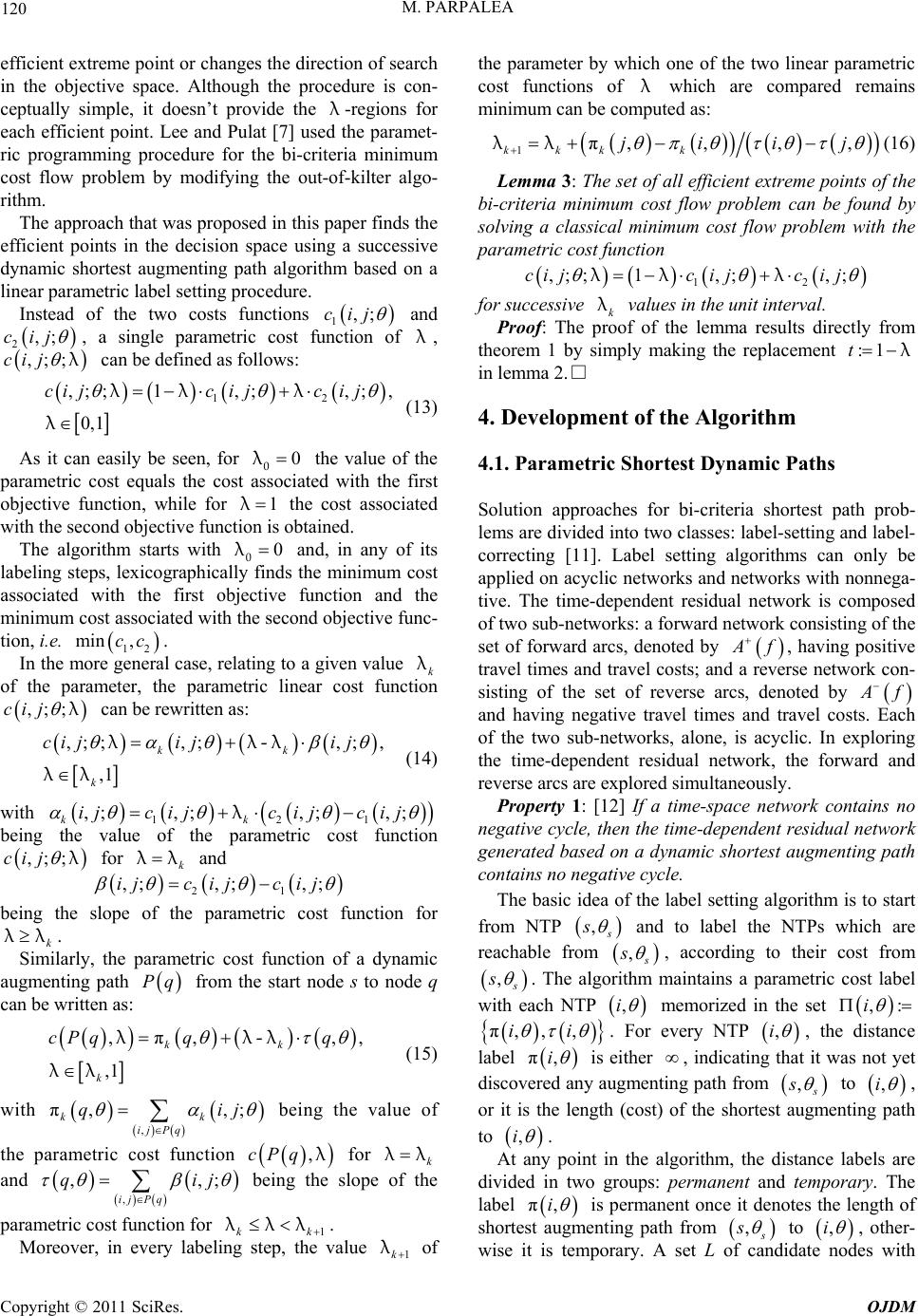 M. PARPALEA 120 efficient extreme point or changes the direction of search in the objective space. Although the procedure is con- ceptually simple, it doesn’t provide the λ -regions for each efficient point. Lee and Pulat [7] used the paramet- ric programming procedure for the bi-critia minimum cost flow problem by modifying the out-of-kilter algo- rithm. The approach that was proposed in this paper finds the efficien er t points in the decision space using a successive dynamic shortest augmenting path algorithm based on a linear parametric label setting procedure. Instead of the two costs functions 1,;cij and 2,;cij , a single parametric cost function of λ , ,;;ij c λ can be defined as follows: 12 ;1,;,; ,c ijcij ,; 0, 1 cij λλ λ λ (13) As it can easily be seen, for talue parametric cost equals the cowith the first ob mum cost as 0 0 λ st associate 1 th he v d of the jective function, while for λe cost associated with the second objective function is obtained. The algorithm starts with 0 and, in any of its labeling steps, lexicographically finds the mini 0 λ jectivesociated with the first ob function and the minimum cost associated with the second objective func- tion, i.e. 12 min ,cc . In the more general case, relating to a given value k λ of the parameter, the parametric linear cost function ,;;ij c λ can be rewritten as: ;,;,; , kk ij ij ,; ,1 k cij λλ-λ λλ (14) with 121 ,; ,;,; kk ijc ijcijc i,;j λ he value of the paramefunction ;; being ttric cost ,cij λ for k λ λ and 21 ,;,; ,;ijcijc ij slope parabeing the of themetric cost function for k λ λ . Similarly, the parametric cost function of a dynamic augmenting path from the start node s to node q ca Pq n be written as: ,,,cPq qq π, ,1 kk k λλ-λ λλ (15) with ;j , π,, kk ij Pq qi being te rametric cost function hvalue of the pa ,Pq c λ for k λ λ and ,,qi ;j ,ij Pq being the slope of the of of the two linear parametric co param 1kk λ etric cost function for λ λ . Moreover, in every lavalue beling step, the 1k λ the parameter by which one st functions of λ which are compared ains minimum can be computed as: rem 1π,,,, kkk k jiij λλ (16) Lemma 3: The set of all efficient extreme points o bi-criteria minimust flow problem can be foun so f the d by m co lving a classical minimum cost flow problem with the parametric cost function 12 ,;; 1,;,;cijc ijcij λλλ for successive k λ values in the unit interval. Proof: Thma results directly from im e proof of the lem theorem 1 by sply making the replacement :1t λ in mntthe Algorithm ths th prob- ms are divided into classes: label-setting and label- lemma 2.□ 4. Develope of o tw 4.1. Parametric Shortest Dynamic Pa Solution approaches for bi-criteria shortest pa le correcting [11]. Label setting algorithms can only be applied on acyclic networks and networks with nonnega- tive. The time-dependent residual network is composed of two sub-networks: a forward network consisting of the set of forward arcs, denoted by A f , having positive travel times and travel costs; and a reverse network con- sisting of the set of reverse aroted by cs, den A f and having negative travel times and travel costs. Each of the two sub-networks, alone, is acyclic. In ex the time-dependent residual network, the forward and reverse arcs are explored simultaneously. Property 1: [12] If a time-space network contains no negative cycle, then the time-dependent re ploring sidual network generated based on a dynamic shortest augmenting path contains no negative cycle. The basic idea of the label setting algorithm is to start from NTP , s s and to label the NTPs which are reachable from , s s , according to their cost from , s s . The algorithm maintains a parametric cost label with each NTP ,i memorized in the set ,:i , ,iπ,i . For every NTP ,i , the distance label π,i is either , indicating that it was not yet ugmenting path from discovered any a , s s to ,i , or it isngth (cost) the shortest augmenting path to the leof ,i . At any point in the algorithm, the distance labels are divided in two groupermanent and temporary. The la ps: bel π,i is permanent once it denotes the length of shortest augmenting path from , s s to ,i , other- wise it is temporary. A set L of candidate nodes with Copyright © 2011 SciRes. OJDM 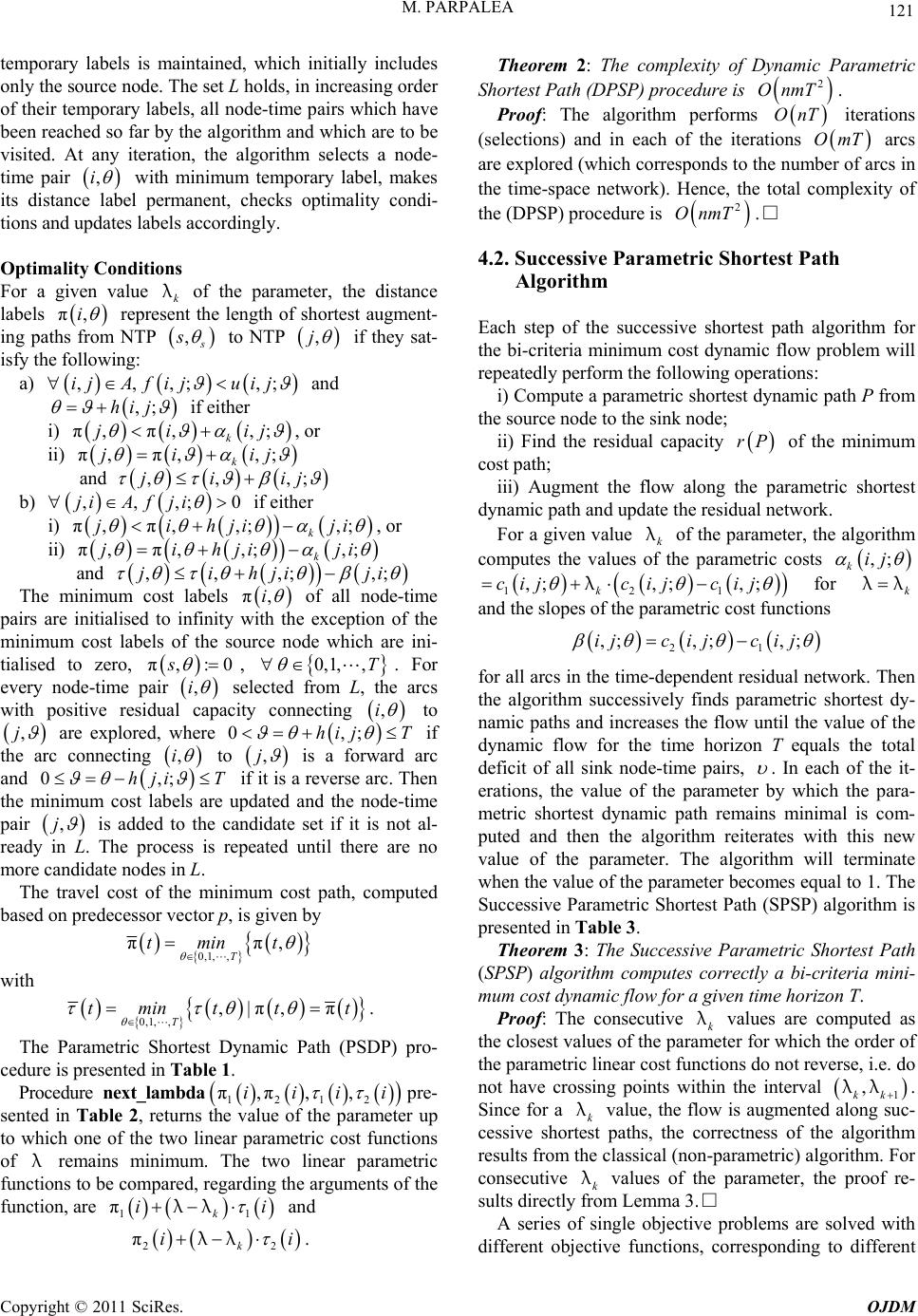 M. PARPALEA 121 whichlly itemporary labels is maintained, initiancludes only the source node. The set L holds, in increasing order of their temporary labels, all node-time pairs which have been reached so far by the algorithm and which are to be visited. At any iteration, the algorithm selects a node- time pair ,i with minimum temporary label, makes its distance label permanent, checks optimality condi- tions and us labels accordingly. Optimality Conditions pdate n vaFor a givelue k λ of the parameter, the distance labels π,i represent the length of shortest augment- ing paths from NTP , s s to NTP ,j if they sat- isfy theing: a) ,, ,;ijAfiuij follow ,;j ,hij and ; if either i) ,, kijπ,πji; , or ii) π,ji jπ,, ki; , ,,ji ;jand i ,,,;0A fji if either b) ji , π,,jih i) π,j ; ; k ji i π,, , k jihj j , or ii) ;i π,;i ,, ,;,jihji ; i and j cost labels π,i The minimum of all node-time e exception of m pairs are initialised to infinity with ththe inimum cost labels of the source node which are ini- tialised to zero, π,:0s , 0,1, ,T . For every node-time pair ,i selected from L, the arcs with positive resitydual capaci connecting ,i to ,j are explored, w 0,;hij T here if the arc connecting ,i to ,j is a forwarc ;hji T en the minimum cost labre up and the node-time pair ar reverse arc. T d hand 0, els a if it is a dated ,j is ad didate n ded to the candidate set if it is not al- ready in L. The process is repeated until there are no moreodes in L. The travel cost of the minimum cost path, computed based on predecessor vector can p, is given by 0,1,, ππ, T tmint with 0,1,,,|π,π T tmint tt . The Patric Shortest Dynamic Path (PSDP) pro- cedure is ted in Table 1. rame presen Procedure next_l ambda 1212 π,π,,iiii pre- sented in Table 2, returns the value of the parame ear parametric cost functions ter up to which one of the two lin of λ remains minimum. The two linear parametric functions to be compared, regarding the arguments of the function, are Theorem 2: The complexity of Dynamic Parametric Sh 11 πk ii λλ and i . 22 πk iλλ ortest Path (DPSP) procedure is . Proof: The algorithm performs iterations (se 2 OnmT OnT lections) and in each of the iterations T arcs are explored (which corresponds to the num of rcs in the time-space network). Hence, the total complexity of the (DPSP) procedure is Om ber a 2 OnmT .□ 4.2. Successive Parametric Shortest Path achsuccessive shortest path algorithm for the p Algorithm step of the E the bi-criteria minimum cost dynamic flow problem will repeatedly perform the following operations: i) Compute a parametric shortest dynamic path P from the source node to the sink node; ii) Find the residual capacity rP of the minimum cost path; iii) Augment the flow along arametric shortest dynamic path and update the residual network. For a given value k λ of the parameter, the algorithm coof hmputes the values te parametric costs ,; kij 121 ,;,; ,; k cijc ijcij λ for k λ λ and the slopes of the ions parametric cost funct 21 ,;,; ,;ijcijc ij for all arcs in the time-dependent residual network. Then the algorithm successively finds parametric shortest dy- namic paths and increases the flow until the value of the dynamic flow for the time horizon T equals the total deficit of all sink node-time pairs, . In each of the it- erations, the value of the parameter by which the para- metric shortest dynamic path remains minimal is com- puted and then the algorithm reiterates with this new value of the parameter. The algorithm will terminate when the value of the parameter becomes equal to 1. The Successive Parametric Shortest Path (SPSP) algorithm is presented in Table 3. Theorem 3: The Successive Parametric Shortest Path (SPSP) algorithm computes correctly a bi-criteria mini- mum cost dynamic flow for a given time horizon T. Proof: The consecutive k λ values are computed as the closest values of the parameter for which the order of the parametric linear cost functions do not reverse, i.e. do not have crossing points within the interval 1 , kk λλ . Since for a k λ value, the flow is augmented along suc- cessive shortest paths, the correctness of the algorithm results from the classical (non-parametric) algorithm. For consecutive k λ values of the parameter, the proof re- sults directly from Lemma 3.□ A series of single objective problems are solved with different objective functions, corresponding to different Copyright © 2011 SciRes. OJDM 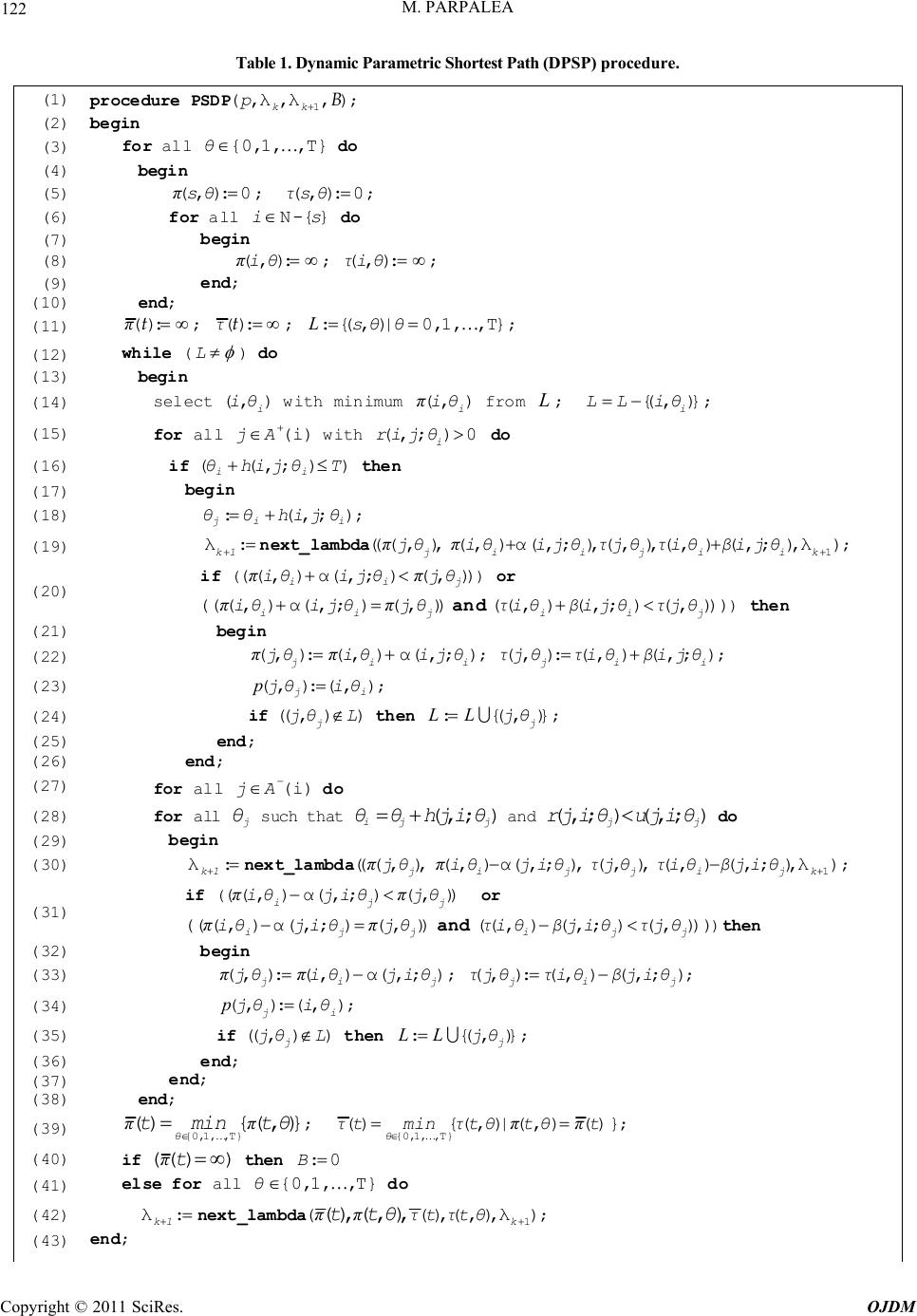 M. PARPALEA Copyright © 2011 SciRes. OJDM 122 hors t Path (DPSP) procedure. Table 1. Dynamic Parametric S (1) procedure PSDP te ),λ,λ,( 1B kk p; (2) beg in (3) for all T},1,{0,θ do (4) begin (5) 0:),(θsπ; 0:),( θsτ; (6) for all }{-N si do (7) begin (8) :),( θiπ; :),( θiτ; (9) end; (10) end; (11) :)(tπ; :)(tτ; }T,1,0,|),({: θθsL; (12) while ( L) do (13) begin (14) select ),( i θi with minimum ),( i θiπ from L; }),({ i θiLL ; (15) for all (i ) Aj with 0);,( i θjir do (16) if ));,(( Tθjihθii then (17) begin (18) );,(: iij θjihθθ ; (19) :λ1k next_lambda )λ,);,(),(,),(,);,α(),( ,),(((1 kiijiij θjiβθiτθjτθjiθiθjππ; (20) if ()),();,α(),(( jiiθjθjiθiππ ) or ))),();,(),(( )),();,α(),(((jiijii θjτθjiβθiτθjθjiθiandππ ) th en (21) begin (22) );,α(),(:),( iij θjiθiθjππ; );,(),(:),(iij θjiβθiτθjτ ; (23) ),(:),( ij θiθjp; (24) if )),(( Lθjj the n }),({: j θjLL ; (25) end; (26) end; (27) for all (i) Aj do (28) for all j θ such that );,( jji θijhθθ and );,();,( jjθijuθijr do (29) begin (30) :λ1k next_lambda)λ,);,(),( ,),( ,);,α(),( ,),(((1 kjijjij θijβθiτθjτθijθiθjππ; (31) if ()),();,α(),(( jji θjθijθiππ or ))),();,(),(( )),();,α(),(((jjijji θjτθijβθiτθjθijθi andππ )then (32) begin (33) );,α(),(:),(jij θijθiθjππ; );,(),(:),(jij θijβθiτθjτ ; (34) ),(:),( ij θiθjp; (35) if )),(( Lθjj then }),({:j θjLL ; (36) end; (37) end; (38) end; (39) }),({)( T},1,{0, θtmintθππ ; )}(),(),({)( T},1,{0, tθt|θtτmintτ θππ ; (40) if ))(( tπ then 0:B (41) else for all T},1,{0, θ do (42) :λ1knext_lambda )λ,),(,)(( 1 ,),(,)(k θtτtτθttππ ; (43) end; 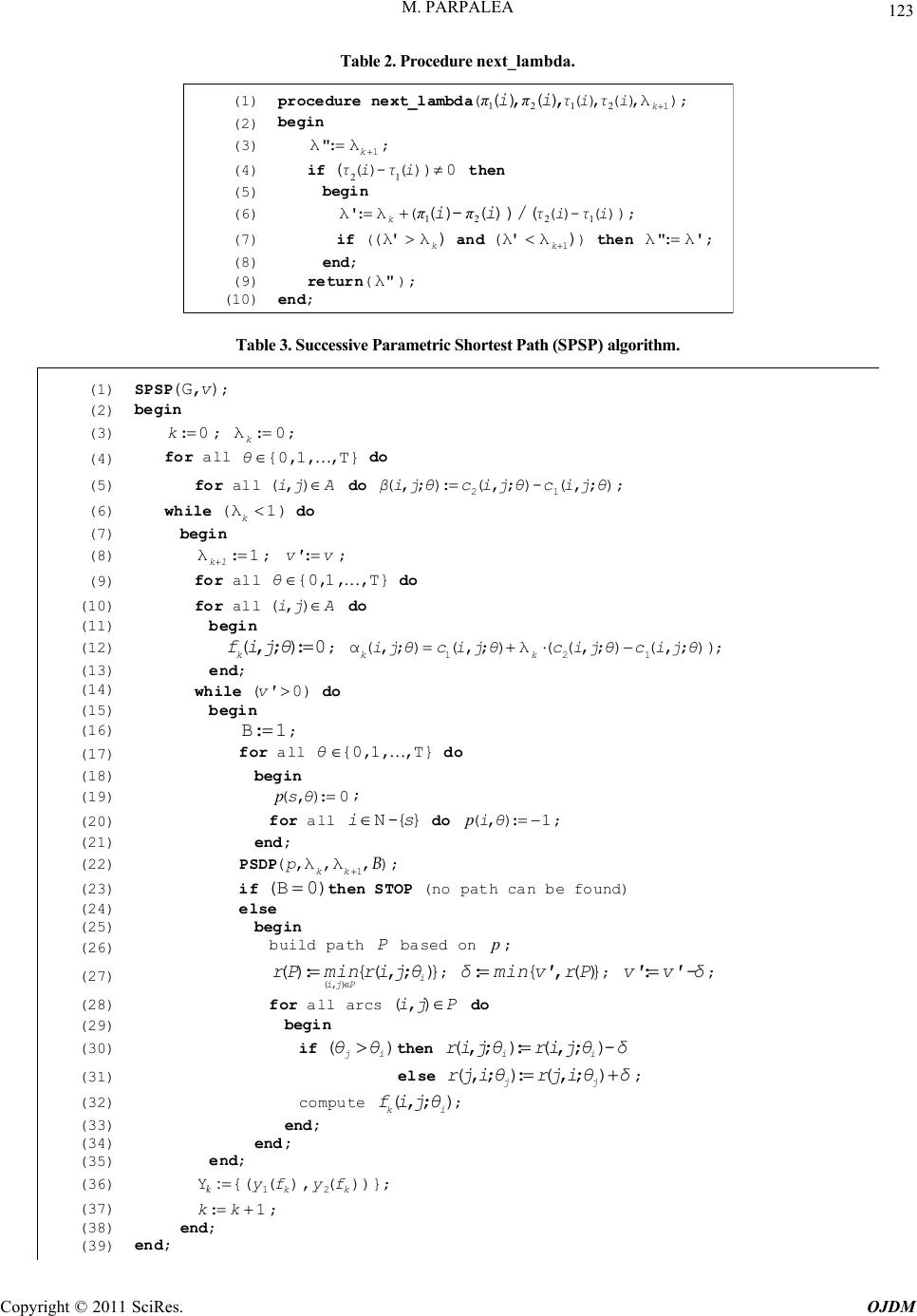 M. PARPALEA 123 Ta b le 2. P r oc e du r e next_lambda. (1) procedure next_lambda)λ,)(,)(( 1 ,)(,)( k iτiτii 2121 ππ ; (2) begi n (3) 1 λ:λ" k; (4) if 0))(-)((iτiτ12 then (5) begin (6) ))(-)((λ:λ'))/((-)( iτiτii k1221ππ; (7) if ()λ '(λk and ) 1 λ '(λ k) th en λ':λ"; (8) end; (9) return(λ"); (10) end; Table 3. Successive Parame tric Short est Path (SPSP) algorithm. (1) SPSP )(G,v; (2) begin (3) 0:k; 0:λ k; (4) for all T},1,{0, θ do (5) for all Aji ),( do );,(-);,(:);,( 12 θjicθjicθjiβ; (6) while 1)(λ k do (7) begin (8) 1:λ 1k ; vv' :; (9) for all T},1,{0, θ do (10) for all Aji ),( do (11) begin (12) 0:);,( θjifk; ));,();,((λ);,();,(α121 θjicθjicθjicθji kk ; (13) end; (14) while 0)(v' do (15) begin (16) 1:B ; (17) for all T},1,{0,θ do (18) begin (19) 0:),(θsp; (20) for all }{-N si do 1:),( θip; (21) end; (22) PSDP),λ,λ,( 1B kk p; (23) if 0)(B then STOP (no path can be found) (24) e lse (25) begin (26) build path P based on p; (27) });,({:)( ),( i Pji θjirminPr ; })(,{:Prv'minδ; v'-δv':; (28) for all arcs Pji ),( do (29) begin (30) if )( ijθθ then δθjirθjir ii -);,(:);,( (31) else δθijrθijr jj );,(:);,( ; (32) compute );,( ik θjif ; (33) end; (34) end; (35) end; (36) ))}(),({(Y21 kk fyfy: k; (37) 1: kk ; (38) end; (39) end; Copyright © 2011 SciRes. OJDM  M. PARPALEA Copyright © 2011 SciRes. OJDM 124 k λ term maxi values, and each problem leads (for the non-degen- erate case) to a new efficient solution. The algorithm inates when the value of the parameter reaches to the mum value of the unit interval. Starting with 0 k λ for 0k and ending when for 1 kλkK , the K performs steps linear segments between two consecutive efficient ex- treme points. Theorem 4: The complexity of the Successive Para- metric Shortest Path (SPSP) algorithm for computing the t of efficient extreme points in the decision space is For the labelling operation and computing pa- rametric costs, all arcs at all times have to be examined, so the running time is . Updating the residual networks after augmow also requires a run- ning time of ost algorithm Kcorresponding to the se 2 OKnmTv. Proof: OmT enting the fl . Since at m OmT augmentations are done by tDPSP is called he algorithm, procedure times for every k λ trem value of th com e eter. Hence efficient exe point is param puted in an OmT onseque segments be- + ntly, OmT + for the K 2 OnmT steps corresp , on i.e. ding to 2 T linear Onm the K . C tween two consecutive efficient extreme points, the total complexity of the SPSP algorithm is 2 OKnmT . rk presented in 3 □ Fig- 5. Example In the discrete-time dynamic netwo ure 1(a), the problem is to send units of flo rce node s (nod e horizon wh acity) of all ar w at e 1) ich is cs ar minimum bi-criteria cost from th to the sink node t (node 5) with set to T = 4. The upper bounds (e set to e sou in a tim cap ,;: 2uij , ,ij A osts are , 0,1, 2,3 sented in Table , 4 4. and the ts and c lope ransit timepre ,;j 2 ,;ijc i In the initialisation step, the s 1,;cij puted (as pr of the parametric costs esented in Table 4) an corresponding initial value of th functions are c for 0 k and e parameter 0 om- th 0 d, e λ, 01 ,;c ij,; :ij m for the so is initialised at all ti nodes except are set. Th e values to urce node, e predecessor ve ,:1pi fo r which ctor r all fo ,ps is sed to set to zero, and procedure PSDP Iteration 1: The distance labe is called. ls are initiali π1,: 0 for 0,1, ,T and the set L of can- didate nodes is set to : 1,0,1L ode-time pair, (1,0 ,. ) is removed from the 1,1,2,1,3,1,4 The selected n Figure 1. (a) The dynamic network G considered for exemplifying how the Successive Parametric Shor test Path (SP S P) algorithm works; (b) The set of all non-dominated points which lie on the efficient boundary in the objective space for the bi-criteria minimum cost dynamic flow problem in network G . Table 4. Transit times and costs on arcs for the dynamic network in Figure 1. (i,j) (1,2) (1,3) (2,4) (2,5) (3,4) (3,5) (4,5) 2, 01 3, 1 1, 02 2, 2 3, 02 1, 2 1 2, 02 1, 2 1, 02 3, 2 1 h(i,j; ) c1(i,j; ) 2 2 7 9 4, 02 5, 2 7 1 c2(i,j; ) 3 4 2 2 6, 02 1, 2 5 5 β(i,j; ) 1 2 –5 –7 4, 2 2, 02 –2 4 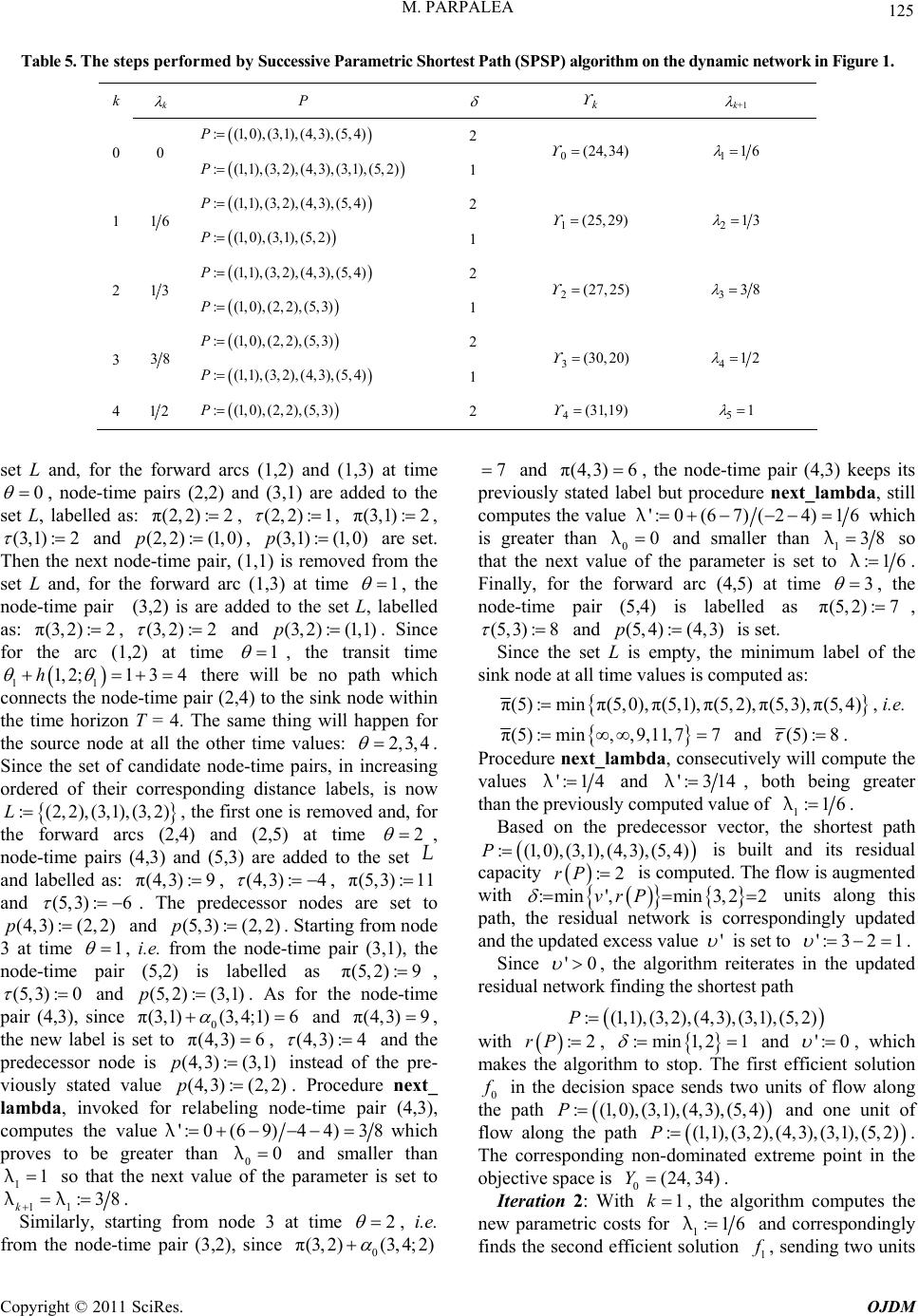 M. PARPALEA 125 test ath (SPSP) algorithm on the dynamic network in Figure 1. Table 5. The steps performed by Successive Parametric Shor k k P P k k+1 : (1,0),(3,1),(4,3),(5,4)P 2 0 0 : (1,1),(3,2),(4,3),(3,1),(5,2)P0(24,34) 16 1 1 : (1,1),(3,2),(4,3),(5,4)P 1 2 16 : (1,0),(3,1),(5,2)P 1(25, 29) 213 1 : (1,1),(3,2),(4,3),(5,4)P 2 2 13 :(1, 0), (2, 2), (5, 3)P 2(27, 25) 338 1 ), (2, 2), (5, 3) 3 :(1, 0P2 38 : (1,1),(3,2),(4,3),(5,4)P 3(30, 20) 412 1 4 12 :(1, 0), (2, 2), (5,3)P 4(31,19) 51 2 d,ward ad (1,3) at time 0 set L an for the forrcs (1,2) an , node-time pairs (2,2) and (3,1) are added to the set L, labelled as: π(2,2) :2, (2,2) :1 , π(3,1):2 , (3,1):2 and (2,2):(1,0)p, (3p.,1):( ,1) is rem (1,3) at time 1,0) are set oved from the 1 xt no for th Then t set L he ne and, de-time pair, (1 e forward arc , the t L, labelled e pair node-tim as: π(3 (3,2) is are adde (3, 2):2 d to the se , 2) :2, ) at time and ,2 (3,2):p 1 (1,1) . Since for the arc (1 will be ) to the si me time values: , the transit time no path which nk node within thing will happen for 2,3,4 11 e node horizon 1, 2; h e rc 1 T e node at all th 3 4 there -time pair (2,4 = 4. The sa e other h connects t the tim the sou . in increasing bels, is now oved and, for me 2 Since the ordere : (L the fo set of candidate nod rresponding 3,2) , the first 2,4) and ( e-time pairs, distance la one is rem 2,5) at ti d of 2,2) rwar thei ,(3,1) d r co ,( arcs ( , o the set L node-time pairs (4,3) and (5,3) are added t and labelled as: π(4,3):9, (4,3) :4 , π(5,3):11 and (5,3):6 . The predecessor nodes are set to (4,3) :(2,2)p and (5,3):(2,2)p . Starting from node 3 at time 1 e pair ( , i.e. from th 5,2) e node-time pair (3,1), the is labelled as π(5, 2) :9 node-tim , (5,3) :0 ,3), a since nd (5,2):)p 0 (3,1) (3, (3,1. As f ;1)6 or the node-time pair (4π4 and π(4,3) 9 , the new label is set to π(4,3) 6 , (4,3) :4 and the predecessor node ( is (4,3) :p3,1) instea (2,2) d of the pre- viously stated value (4,3) :p . Proc ling node-tim edure next_ e pair (4,3),lambda com , in putes the voked for relabe value': 0(6λ ter than λ ext value 9) 44)3 0 and smalle he parameter is 8 wh set ich r than to proves to 11λ be grea0 at the n so thof t 1k λ Sim 1 :λ ilarly, 38. startin g from node 3 at time 2 , i.e. from the node-time pair (3,2), since 0 π(3, 2)(3, 4;2) 7 and π(4,3) 6 , the node-time pair (4,3) keeps its tated ure next_lambda, still computes the value previouslybut proced slabel ':0(67)(24)16 λ is greater than 00 which λ and smaller than 138 λ so that the nehe parameter is set to xt value of t:16 λ. Finally, fod arc (4,5) at time r the forwar3 , the -tim is labelled as nodee pair (5,4)π7(5,2): , (5,3) :8 and (5,p4) :(4,3) is set. inimum puted as: Since the set L is em sink node at all time pty, the m values is com label of the (5, 4),π(5):min π(5,0), π(5,1), π(5,2), π(5,3), π i.e. , 77 and π(5):min,,9,11 (5) :8 pute the . comProcedure , consecutively will values next_lambda ':14 λ and ': 314 λ, both b than thf eeatering gr e previously computed value o1 λ h :16. e shortest pathBased vector, t on the predecessor : (1,0),(3,1),4)P is built and its residual ,(4,3),(5 capacity :2rP is computed. The flow is augmented with :min',min3,22vrP units along this path, the resiork is and the updated evalue dual netw xcess corresp ' ondi ngly updated is set to ': 321 . Since '0 , the algorithm reiterates in th residuetwor the shath e updated al nk findingortest p ) : ,2),(4,3),(3,1),(5,2P(1,1),(3 with :2rP , in1,21 and :m ': 0 , which ution ma kes the algorithm to stop. The first efficient sol 0 f in the the path decision space sends two units of flow along ) :P along th (1,0),(3,1 e path ),(4,3),(5,4 and one unit of flow ),(3,1),(5,2) int in th : (1,1),(3, dominad (24,34) 2),( ex 4. treme ,3P ing non- is 0 Y The correspond space tee po objective . 1 Iteration 2: With k , thle agorithm computes the new parametric costs for 1:16λ and co rrespondingly finds the second efficient solution 1 f , sending two units Copyright © 2011 SciRes. OJDM 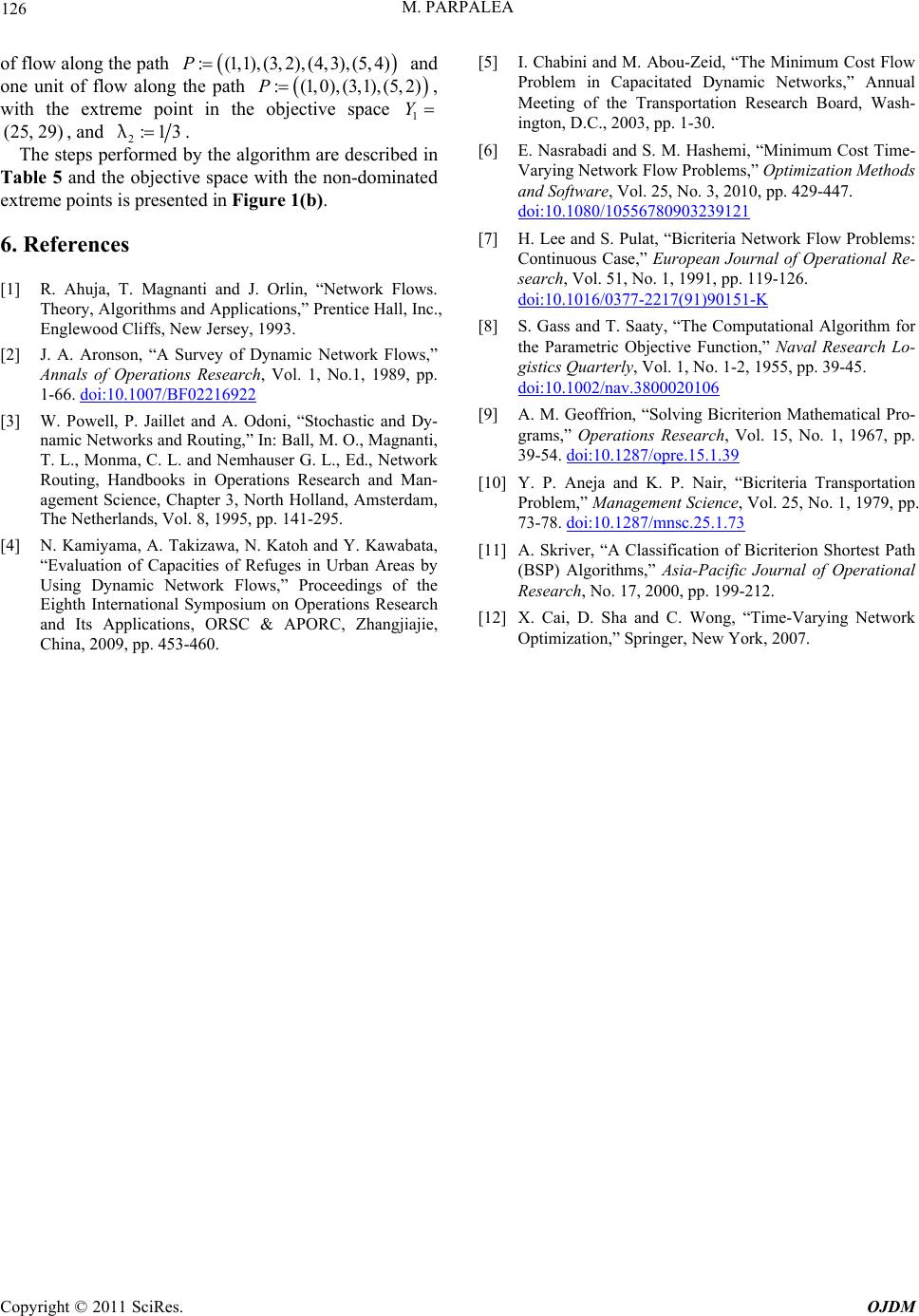 M. PARPALEA 126 of flow along t pat and one unit of flow alo with the extree point heh :(1,1),(3,2) 4,3),(5,4)P ng the path : (1,0),(3,1),(5,P in the objective space ,( 2) , 1 Y m (25,29) , and 2:13. ed by the algorithm are describe space with the non-doi ted in Figure 1(b). gnanti and J. Orlin, “Network Flows. s and Applications,” Prene Hall, , New Jersey, 1993. of Dynamic Network , Vol. 1, No.1, 1 steps perform nd the objective e points is prese R. Ahuja, T. Ma y, Algorithm Englewood Cliffs J. A. Aronson, “A Survey Annals of Operations Research λ The Table 5 a extrem 6. References [1] Theor [2] d in nated Inc. Flows,” 989, pp. , m n tic 1-66. doi:10.1007/BF02216922 [3] W. T agem Chin Powell, P. Jaillet and A. Odoni, “Stochastic ooks in Operations Research and e, Chapter 3, North Holland, A Kaw on & a, 2009, pp. 453- I. Chabini and M. Abou-Zeid, “Tost Flow Problem in Capacitated Dynamic Networks,” Annual Meeting of the Transportation Research Board, Wash- ington, D.C., 20. 1-30. E. Nasrabadi and S. M. Hashemi, “Minimum Cost Time- Varying Network Flow Problems,” Optimization Methods and Software, V, No. 3, 2010, pp. 429-447. and Dy- Man namic Networks and Routing,” In: Ball, M. O., Magnanti, . L., Monma, C. L. and Nemhauser G. L., Ed., Network Routing, Handb- ent Sciencmsterdam, The Netherlands, Vol. 8, 1995, pp. 141-295. [4] N. Kamiyama, A. Takizawa, N. Katoh and Y. abata, “Evaluation of Capacities of Refuges in Urban Areas by Using Dynamic Network Flows,” Proceedings of the Eighth International Symposium Operations Research and Its Applications, ORSCAPORC, Zhangjiajie, 460. [5] he Minimum C 03, pp [6] ol. 25 doi:10.1080/10556780903239121 H. Lee and S. Pulat, “Bicriteria Network Flow Problems: Continuous CasEuropean Journal of Operational Re- search, Vol. 51, No. 1, 1991, pp. 119-126. [7] e,” doi:10.1016/0377-2217(91)90151-K S. Gass and T. Sy, “The Computational Algorithm for the Parametric Objective Function,” Naval Research Lo- gistics Quarterly, No. 1-2, 1955, pp. 39-45. [8] aat , Vol. 1 doi:10.1002/nav.3800020106 [9] A. M. Geoffrion, “Solving Bicriterion Mathematical Pro- grams,” Operations Research, Vol. 15, No. 1, 1967, pp. 39-54. doi:10.1287/opre.15.1.39 d K.ransporta 1979, p [10] Y. P. Aneja an P. Nair, “Bicriteria Ttion Problem,” Management Science, Vol. 25, No. 1,p. 73-78. doi:10.1287/mnsc.25.1.73 [11] A. Skriver, “A Classification of Bicriterionh ific Journal Shortest Pat (BSP) Algorithms,” Asia-Pac of Operational ying Network Research, No. 17, 2000, pp. 199-212. [12] X. Cai, D. Sha and C. Wong, “Time-Var Optimization,” Springer, New York, 2007. Copyright © 2011 SciRes. OJDM |

